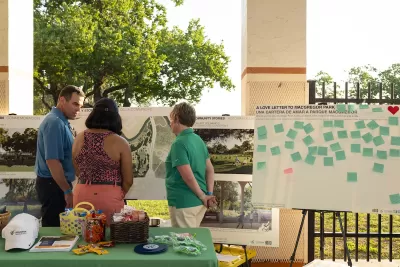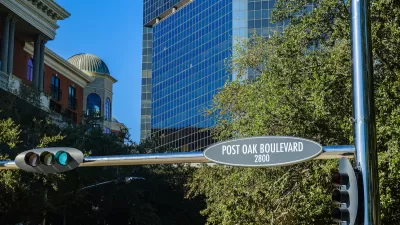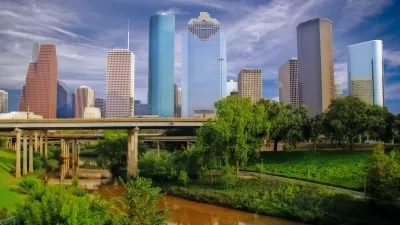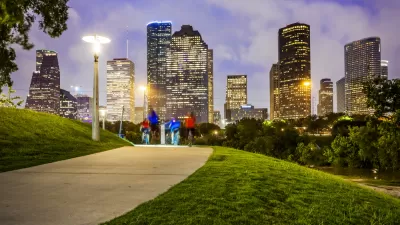Houston may be known to some as a concrete jungle, but its greenspaces continue to expand thanks to combined support from the public, private, and philanthropic sectors.

Despite being the fourth largest city in the United States, Houston often flies under the radar. Many people do not realize that the Houston metropolitan region has almost seven million residents, more Fortune 500 headquarters than any other city except New York and Chicago, and it is one of the most diverse large cities in the country, with an outstanding food and arts scene and over 145 languages spoken across its 640 square miles.
While Houston is a global leader in energy and healthcare, one area where the city lags behind its peers is parks and open space. Decades ago, landscape architect Kevin Shanley described our city in the most unflattering terms: “Miles of aggressive concrete, uninhabited by any living green thing.” Today, thanks to persistent efforts by many, the picture is quite different, with new and reimagined parks and greenspace around Bayou City.
It isn’t just anecdotal evidence that shows the growth and improvement of Houston’s park system; real numbers back it up. Houstonians were encouraged to see their park system continue to climb in the ParkScore® rankings by the Trust for Public Land (TPL) in 2024. ParkScore® measures park systems of the largest 100 cities in the United States with metrics that track access to parks, the amount of park space in each city, and how park systems are funded. Up three spots from last year, Houston sits at #68 overall in the United States. Despite these gains, Houston is still ranked below other major Texas cities in ParkScore®, and well below where we would like to be.
What’s keeping Houston from climbing the ranks further? It can largely be attributed to a major challenge: lack of available public funding.
The ‘Bayou City’ holds more park acreage and people than Dallas, Austin, or San Antonio. However, public spending on parks pales in comparison to our counterparts. Houston currently spends $66 per resident on parks, falling behind Dallas ($108 per resident), San Antonio ($127 per resident), and Austin ($181 per resident), according to ParkScore®.
The lack of available public funding for parks and greenspace has forced Houston to rely on public-private partnerships for many park projects. In fact, data from ParkScore® shows that Houston leads the state in private funding with $43 spent per resident and is the sixth highest of any city in the country, on a per capita basis.
How do these partnerships come together?
Houston Parks Board, a not-for-profit that has championed parks and greenspaces since 1976, is the local leader working to expand, improve, and protect parks and greenspace throughout the region. The organization was founded by a group of philanthropists who came together to support Houston’s neighborhood parks by leveraging private funding to support public parks.
In the last five decades, Houston Parks Board has grown from a staff of one to a team of over 50 professionals. Our organization consists of experts in urban planning, landscape design, development, and conservation practices. These varied skill sets and our long-term planning horizon have allowed us to make a significant impact on Houston’s park development. Houston Parks Board has completed improvements in over 250 parks, with a total investment of over $400 million.
Houston doesn’t have mountains or beaches, but we have 22 bayous that flow through the region. Through our largest initiative to date, Bayou Greenways, we have built a system that has created and connected over 150 miles of trails and provided access to over 3,300 acres of greenspace along Houston’s bayous, and we’re not done yet. To date, we have raised and invested over $240 million in building out this network of greenways with pedestrian and bike trails to connect Houstonians.
This ambitious undertaking was made possible thanks to a public-private partnership between Kinder Foundation, the City of Houston, and Houston Parks Board. A critical component of this project is the long-term conservation and maintenance of Bayou Greenways trails and amenities. Houston Parks Board maintains the Bayou Greenways system through this partnership, which provides approximately $12 million per year in dedicated public funding — protected from budget cuts — toward conservation and maintenance activities.
The bayous flow through the diverse range of neighborhoods and communities that comprise the Greater Houston area. Bayou Greenways cuts through physical and societal barriers to connect these communities, providing new recreational spaces and more access to parks for all Houstonians.
This project creates and enhances recreational parkland, forming a cohesive trail system that provides safe spaces to walk, run, or roll. Another unique aspect of Bayou Greenways is that it connects existing trails that bridge together different parts of the region, creating access to our bayous, transportation corridors, and pathways that previously didn’t exist.
Jewels along a green necklace
Bayou Greenways stands as one of the city’s largest single investments in Houston’s push toward more equitable greenspace. Bayou Greenways also serves as the backbone of a growing system that has expanded and improved greenspace throughout the region. Two examples of that expansion are the MacGregor Park and Hill at Sims projects that commenced in 2024, bringing new and reimagined regional parks along Bayou Greenways. These investments are creating a series of jewels along a green necklace for generations of Houstonians to enjoy.
In December 2023, the Houston City Council approved the master plan and provided funding for transformative renovations to the historic MacGregor Park. This 100-year-old park, one of Houston’s original regional parks, is well-loved but also well-worn.
The main desire of Houston Parks Board and the City of Houston is that MacGregor Park’s transformation preserves the Houston treasure for future generations, without forgetting the community that made the park the icon it is today. Houston Parks Board led a robust community engagement process that resulted in more than 1,200 community interactions. Through organized meetings, events, and surveys, the project team successfully received and incorporated the community’s wants and needs into the fabric of the plan.
This investment is yet another development made possible by the power of private philanthropy, led by a $27 million catalyst gift from Kinder Foundation. In addition to the catalyst gift, as well as local, state, and federal funds, Houston Parks Board launched a fundraising campaign to secure the remaining funds needed to bring the vision for MacGregor Park to life.
Increasing access to parks is a longstanding priority of Houston Parks Board. At MacGregor Park, the existing perimeter trail will be extended by more than a mile to link to the Bayou Greenways trail system along Brays Bayou, which currently has over 38 miles of trails open to date. The project will also refurbish and preserve the Dr. Martin Luther King, Jr. plaza, a central landmark to this community. We anticipate the MacGregor Park transformation to be completed by the end of 2028.
Stormwater detention basins are a vital tool in combatting flooding that occurs during heavy rainfall events. In Houston, where we deal with frequent and repetitive flooding, these detention basins take up significant space and are usually not accessible by the community. At the Hill at Sims project in the Sunnyside neighborhood, we are working with Harris County Precinct One and the Harris County Flood Control District to blend greenspace and flood mitigation to create more parkland for the community. Through our partnership with Harris County and with $7.5 million in private funding from The Brown Foundation, Inc., this project will transform a 100-acre regional stormwater detention basin into a public park that will serve multiple purposes.
The new nature-and-education-focused park will add recreational amenities to the existing detention basin and provide 4.5 miles of new hike-and-bike trails. A new pedestrian bridge will connect the Hill at Sims park to the 20-mile segment of the Bayou Greenways system along Sims Bayou. Other enhancements include a hilltop pavilion providing a panoramic view of Houston, as well as a 1.6-mile loop and other nature trails. We anticipate construction to be completed by 2026.
And what about neighborhood parks?
Public-private partnerships can have an enormous positive impact on neighborhood parks, where the majority of people can experience parks and nature. A quality neighborhood park is key to a healthy community. Not only does it provide safe access to an outdoor space for exercise and gatherings, it also allows neighbors from all walks of life to come together and build a sense of community. When these spaces are used and cared for, a sense of ownership is created, which goes a long way toward preserving a park’s amenities.
Houston is home to more than 186 neighborhood parks ranging in size from one to 15 acres. Through our work on neighborhood parks, private donors can partner with us and the public sector to invest in parks across the city.
Alongside our partners at the City of Houston, Houston Parks Board proudly transformed 22 parks in underserved communities across Houston in 2023. This work was possible thanks to a combined investment of $24 million between the City of Houston and more than 30 foundation and corporate donors. This work, which touched neighborhoods across the city, is being expanded with a new partnership with the City of Houston to provide improvements to additional parks. Through the power of public-private partnerships, Houston Parks Board and other green groups can leverage resources and relationships to maximize the impact of each project.
Creating park stewardship through community engagement
The most critical component of any park development is the community engagement process. Each community is unique and has different needs and desires. In all projects, whether a neighborhood park, a large destination park, or a greenway, the final product must reflect the community it serves.
By focusing on outreach and engagement, we ensure that the community has a voice in how an investment will be used in their area. Our team regularly hosts listening sessions and conducts public surveys to hear what the community wants in its new park directly from its members.
It is essential that we eliminate barriers to ensure all voices are heard. We work to expand opportunities to attend meetings by offering free childcare and food, as well as full language assistance services. The engagement doesn’t end there. When the project scope reaches a milestone, the team presents the design to the community and allows the chance for feedback on planned upgrades. At completion, the community is engaged in creating a meaningful event to celebrate their park.
Going a step further, this process empowers community members to be stewards of their neighborhoods. They can become advocates for and help maintain these spaces, as well as understand how to work with public sector partners to address the wants and needs of their community. Last year, Houston Parks Board convened 41 meetings, reaching more than 7,000 people who are passionate about parks and greenspace, and actively providing input, feedback, and volunteering.
The journey toward increased and sustained public funding for parks is an uphill climb, but we will continue to work with our public and private partners to build a more resilient Houston. Public-private partnerships are powerful and creative tools that any city can use to invest in its parks so that every neighborhood, regardless of its socio-economic status, can benefit from well-maintained and accessible greenspaces.
Beth White is the President and CEO of Houston Parks Board (HPB). With her extensive experience in urban infrastructure, development, and community engagement, Beth is a nationally recognized leader with a proven track record in leading successful public-private partnerships, as well as planning, fundraising, and reimagining and creating new parks and greenspaces. Under her leadership, HPB serves to bring greenspace access to all Houstonians, with Beth spearheading the organization’s vision of an interconnected park and greenspace network for the Houston region.

Trump Administration Could Effectively End Housing Voucher Program
Federal officials are eyeing major cuts to the Section 8 program that helps millions of low-income households pay rent.

Planetizen Federal Action Tracker
A weekly monitor of how Trump’s orders and actions are impacting planners and planning in America.

Ken Jennings Launches Transit Web Series
The Jeopardy champ wants you to ride public transit.

Rebuilding Smarter: How LA County Is Guiding Fire-Ravaged Communities Toward Resilience
Los Angeles County is leading a coordinated effort to help fire-impacted communities rebuild with resilience by providing recovery resources, promoting fire-wise design, and aligning reconstruction with broader sustainability and climate goals.

When Borders Blur: Regional Collaboration in Action
As regional challenges outgrow city boundaries, “When Borders Blur” explores how cross-jurisdictional collaboration can drive smarter, more resilient urban planning, sharing real-world lessons from thriving partnerships across North America.

Philadelphia Is Expanding its Network of Roundabouts
Roundabouts are widely shown to decrease traffic speed, reduce congestion, and improve efficiency.
Urban Design for Planners 1: Software Tools
This six-course series explores essential urban design concepts using open source software and equips planners with the tools they need to participate fully in the urban design process.
Planning for Universal Design
Learn the tools for implementing Universal Design in planning regulations.
Ada County Highway District
Clanton & Associates, Inc.
Jessamine County Fiscal Court
Institute for Housing and Urban Development Studies (IHS)
City of Grandview
Harvard GSD Executive Education
Toledo-Lucas County Plan Commissions
Salt Lake City
NYU Wagner Graduate School of Public Service





























